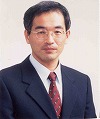|
|
 |
|
|
Computer Network Laboratory |

Shigaku Tei
Professor |

Akio Koyama
Assistant Professor |
Computer Networks Laboratory is working in 3 directions within Research Projects.
Network Protocols
- A Media Access Protocol for Super High Speed Networks
In this research, protocols for single hop Wavelength Division Multiplexing (WDM) networks with passive star topology were studied.
Network/Distributed Algorithms
- QoS based Routing Algorithms
In this research, QoS based Routing Methods Using a Genetic Algorithm were studied.
- Distributed Algorithm for Resource Allocation among Groups
In this research, we presented a new problem which described explicitly the competition for resources among process groups for performing their tasks. Synchronization among the members of every group and exclusion between groups were considered. Solutions which allocate resources to groups of processes with deadlock among groups and starvation of a group never happening were studied.
Agent-based Network Applications
- Personalized WWW-based Distance Education
In this research, aWWW-based Distance Education System was developed. A user can learn content through Internet. The learner's learning historic actions are collected and analyzed. Basedon the analysis results, some of psychological factors on his/her motivation, such as his/her con??dence and attention to the learning can be known at some level, and personalized advice/hints can be given to the learner.
- Match-making network agents which consider psychological factors of users Match-making is a service which helps users to find suitable friends or partners in network environment. We developed methods for match-making, with some psychological factors of users being considered.
|
| [z-cheng-001:2001] | Aiguo He, Zixue Cheng, andTongjunHuang et al. A Multi-site Tele-Seminar Support System Based on Realtime InteractiveCommunication over the Japan Gigabit Network. IPSJ Journal, 43(2):647-661, 2002. |
| [z-cheng-002:2001] | Aiguo He, Zixue Cheng, and Tongjun Huang et al. Development and Evaluation of a Real-time Interactive Tele-Classroom for Computer Exercises Over the Gigabit Network. Journal of Japan Distance Learning Association, 3:26-34, 2001. |
| [z-cheng-003:2001] | Kazuhiko Sato, Shoichi Nakamura, Akio Koyama, and Zixue Cheng. Agent-based Support Systems for Forming Groups Based on User's Kansei. Journal of Japan Society of Kansei Engineering, 2(1):79-86, 2002. |
| [z-cheng-004:2001] | Shoichi Nakamura, Kazuhiko Sato, Misao Fujimori, Akio Koyama, and Zixue Cheng. A Support System for Teacher-Learner Interaction in Learner-oriented Education. IPSJ Journal, 43(2):671-682, 2002. |
| [z-cheng-005:2001] | Akio Koyama, Akira Sasaki, Leonard Barolli, Zixue Cheng, and Aiguo He. Implementation of an Agent Based Mobile Education System. IPSJ Journal, 43(2):577-584, 2002. |
| [z-cheng-006:2001] | Kazuhiko Sato, Zixue Cheng, Shoichi Nakamura, Akio Koyama, Aiguo He, and Tongjun Huang. An Agent-based Persuasion Mechanism for Match-Making between professors and Students. 3D Forum, 15(4):158-163, 2001. |
| [z-cheng-007:2001] | Kazuhiko Sato, Zixue Cheng, Shoichi Nakamura, Akio Koyama, Aiguo He, and Tongjun Huang. A Support Method for Match-making Using Agent's Persuasion Mechanism Considering User's Psychological States. IPSJ Journal, 43(2):513-529, 2002. |
| [z-cheng-008:2001] | Zixue Cheng, Yutaka Wada, Satoru Hashimoto, and Shoichi Noguchi. Local Majority Coterie for EAEcient Allocation of Resources. IPSJ Journal, 42(12):3004-3010, 2001. |
| [z-cheng-009:2001] | Z. Cheng, A. He, T. Huang, A. Koyama, and S. Noguchi. An Overview of an Interactive and Personalized Multimedia Tele-Education Environment over a Gigabit Network. Enabling Society with Information Technology, pages 284-294, 2001. |
| [z-cheng-010:2001] | Kazunori Matsumoto, Akio Koyama, Barolli Leonard, and Zixue Cheng. AQos Routing Method for High-Speed Networks Using Genetic Algorithm. IPSJ Journal, 42(12):3121-3129, 2001. |
| [z-cheng-011:2001] | Akio Koyama, Barolli Leonard, and Zixue Cheng. AnAdaptive Media Access Protocol for Ring Topology Terabit Networks. IPSJ Journal, 42(6):1676-1683, 2001. |
|